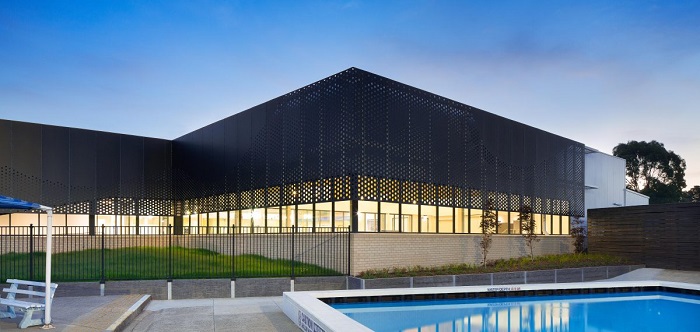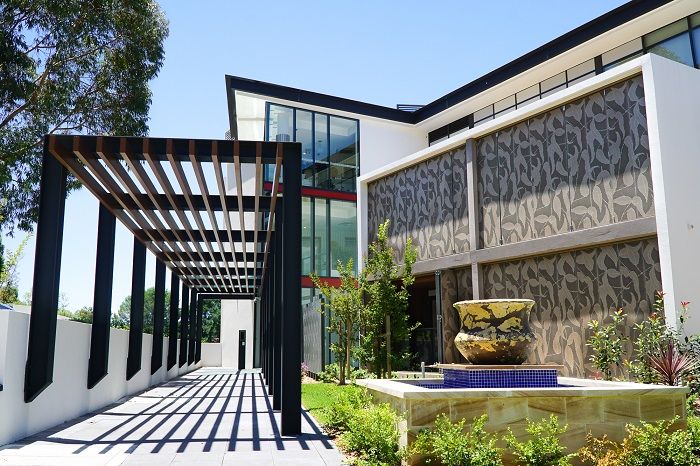Facade choices make or mar buildings. The right facade can instantly change a building’s entire appearance, form, and function and make it blend or stand out impressively. Facades can also make a building green – many architects are opting for eco-friendly perforated metal facades to help boost environmental ratings for their projects.
Arrow Metal presents a short guide on important design considerations for perforated metal facades. The guide also explains why perforated metal is superior to other types of facades when it comes to creativity, architectural expression, and visual impact.
Advantages of a perforated metal facade
Perforated metal facade systems offer considerable benefits for modern architecture projects, including:
Green credentials
Perforated metal is one of the greenest materials around when project sustainability is an important consideration. Not only is it recyclable, a perforated metal facade can also help to reduce a building’s energy costs. Through clever perforation specification, a perforated metal facade allows precise control of light and airflow, whilst also deflecting heat and solar radiation.
Acoustic and airflow advantages
Perforated metal is a sound solution to noise issues. Used together with acoustic materials, a perforated metal facade can reflect, absorb, or scatter nuisance indoor and outdoor noise depending on the specification. Many architects also use a perforated metal facade to attractively ventilate and hide building service machinery.
Design creativity
No other type of facade offers the level of customisation that perforated metal does. Architects can make a building truly unique without compromising on function and performance. There are endless patterns and CAD-drawn customisation options to suit every budget and project schedule.
Perfect privacy solution
Many residential apartments and office blocks have a perforated metal facade because it offers privacy without compromising views, light flow, and ventilation. Choose a closely spaced profile for a sheer veiled effect or opt for a geometric or nature-inspired pattern for interior light play.

Choosing the pattern and metal: What to consider
Now that you know the suitability of a perforated metal facade for your project, the next questions are which pattern, and what metal? These are some of the key factors to bear in mind:
- Whether the facade is purely decorative or also needs to fulfil a particular function – such as acoustics, strength, or energy efficiency;
- The location of the facade on the building – it is possible to use different patterns across the facade to match solar position, heat loss and gain;
- Any climate factors – is the building near the coast? A windy location? The base metal, pattern, and finish need to be able to withstand local environmental conditions.
Talk to your perforated metal manufacturer about your facade requirements – they will be able to advise you on the best metals and patterns to suit your needs and budget.

Pattern and metal options
From custom, unique CAD-drawn designs to bold geometrics in a range of base metals, with perforated metal you have almost limitless design scope for a facade:
- Words, illustrations, or images – choose a theme, pay tribute to local history, or the building’s location.
- Classic round, rectangle, or square patterns – these types of profiles never go out of style.
- Modern geometrics and futuristic shapes – created using the latest punching machinery tooling.
- Mix-and-match designs – different hole styles and sizes on a single panel for an unusual and unique architectural feature.
The most popular metal for facades is aluminium.

All patterns can be customised so that the pitch and open area percentage – the amount of open area or ‘holes’ in the panel – meet exact project requirements.
Panel finishes
A finish is the final process, which alters the surface of the facade panels to create varied looks, brightness, colours, and textures. Some finishes can also help improve durability and resistance to corrosion and wear.
Options include:
- Coloured finish: Available in a spectrum of shades, colours are applied through powdercoating for precise coverage.
- Anodising: Most used for aluminium, often in conjunction with a colour, anodising creates a hard, durable, and weather-resistant coating.
- Weathered and metallic effects: Make a visual feature or give a classic pattern a modern makeover.
- Folds and curves: Create a striking 3D effect or a functional, folding facade for privacy and light.

Installing the facade
How is the facade installed? For seamless and easy fitting, panels typically come with hidden numbers or indicators, which show the order and positioning. This is particularly useful for intricate designs and panels that make up a composite image, logo, or words.

Summary highlights
- Perforated metal offers endless creative design scope and environmental benefits for building facades
- Extensive range of patterns, metals, and finishes – customised to exact project requirements
- Create your own CAD-drawn architectural design – unique to your project
- Easy and seamless installation

Arrow Metal: Perforated metal facade expertise
Arrow Metal perforated metal facade panels have been used for major architectural projects throughout Australia, including luxury residential schemes and cutting-edge, award-winning green buildings. We have considerable expertise in custom facade solutions – contact our expert team for expert advice on metal materials, design options, bespoke facade creation and more.
Main image: Perforated metal panels by Arrow Metal at University of Newcastle

